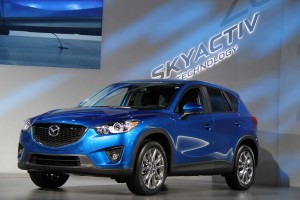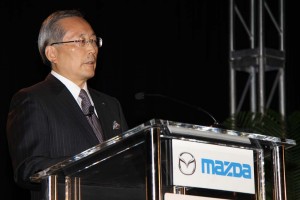With the launch of the new 2013 Mazda CX-5, the Japanese automaker is “planting a stake in the ground” that will very likely determine the future of the zoom-zoom brand.
The third crossover in Mazda’s line-up will introduce the full range of technology that the maker collectively calls Skyactiv. Mazda, which has a history of taking a different path on powertrains with technology like the Wankel rotary engine, is putting itself even further out of the mainstream with the Skyactiv system.
The technology – which ranges from significantly modified gas and diesel engines to a distinctly different approach to body and chassis development – promises to deliver fuel economy that’s as good as more complicated gas-electric hybrid systems, declared Takashi Yamanouchi, the maker’s president and CEO, but also much better performance.
Mazda’s strategy, he said during the keynote speech at the 2011 L.A. Auto Show, is to “improve the efficiency of core technologies and then offer them as standard equipment.”
A limited application of the Skyactiv system will debut on the mid-cycle update of the Mazda3 subcompact, but the all-new Mazda5 goes the proverbial “full Monty.” And, going forward, Skyactiv – which is as much philosophy as technology – will be incorporated into about 80% of the maker’s global line-up.
As TheDetroitBureau.com has previously reported, Mazda has developed a new Skyactiv-G gasoline engine that opts for an unusually high compression ratio of 14:1 – versus a more traditional 9:1 – direct injection and other tricks that can yield diesel-like fuel economy, Mazda claiming about a 15% improvement in mileage as well as a 15% boost in low-end torque.
Mazda also is developing a Skyactive-D diesel it claims can deliver the power and performance of a 4.0-liter V-8 while getting 20% better mileage than what fuel-efficient diesels already deliver.
A new Skyactive transmission is billed as offering yet another 4% to 7% gain in fuel economy.
The next step, debuting with the Mazda CX5, is to opt for a unique Skyactive body and chassis design that Mazda claims should save at least 100 pounds per vehicle.
The Mazda CX5, contends Jim O’Sullivan, CEO of Mazda’s U.S. arm, “proves we really do follow the road less traveled.”
Significantly, Yamanouchi suggested that by rethinking the very design and engineering process Mazda is seeing significant reductions in R&D costs while boosting the output of those operations by as much as 30%.
Mazda’s Skyactiv strategy is not without controversy, especially among those who believe the eventual solution to automotive propulsion needs will come with some form of battery attached. Skeptics wonder whether Mazda is skipping the hybrid route simply because it doesn’t have the financial resources. Complicating the maker’s situation, long-time partner Ford sold off most of its holdings in the Japanese company over the last several years and has reduced their common product development efforts.
Yamanouchi contends Mazda will eventually migrate towards battery propulsion – step-by-step, starting with Auto Stop/Start technology and limited battery regeneration. But he is quick to point out that for all the media hype all forms of battery-based vehicles combined barely hold 3% of the automotive market right now.
While Mazda clearly has its challenges, the Japanese executive expressed only optimism for the future, suggesting it’s Mazda’s goal to build global sales from last year’s 1.3 million to at least 1.7 million over the next four years.
But don’t worry about Mazda going mainstream. If anything, its fascination with unusual technology is clearly going to continue, Yamanouchi pointedly noting, “I’m very attached to the rotary engine, so as long as I am president of Mazda our research in that area will continue.”
Mazda recently pulled the plug on its last rotary-powered model, the 4-door RX-8 sports car, but efforts are underway, TheDetroitBureau.com has learned, to see if the principles of the Skyactiv system could help make even the Wankel rotary efficient enough to find a place in a market where fuel efficiency trumps just about all.


